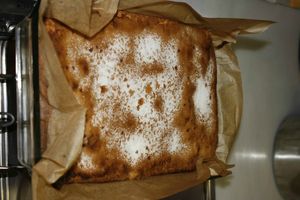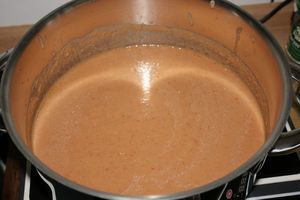Pumpkin soup / Sopa de calabaza / Kürbissuppe

1 calabaza, 1 puerro, mantequilla (1/3 de pastilla, que serán 125g), leche, o caldo, sal, pimienta y nuez moscada.
En un puchero alto, deshacer la mantequilla y freir el puerro cortado finito, al fuego más bajo que tengas. Mientras tanto cortar la calabaza en cubos de unos 2 cm de lado y quitar las pipas (la hokkaido tiene la ventaja de que no hay que pelarla ;-) ). Añadir los cubos a la cazuela y hacer que toda se cubra con la mantequilla. Medio cubrir con leche (o leche y caldo, o leche y agua, ...) y cocer hasta que la calabaza esté blanda.
Picar todo y añadir más caldo / agua / leche para conseguir la consistencia que queráis.
Sal, pimienta y nuez moscada al gusto.
La nuez moscada le da un toque picante que me sorprendió.
1 pumpkin, 1 leek, 125 g butter (1/3 of a "normal" packet), milk, maybe stock, salt, pepper, nutmeg.
In a high saucepan, melt the butter and fry the finely sliced leek (use the smallest flame you can). While this goes on, dice the pumpkin (2 cm x 2 cm) without the seeds. Hokkaido pumpkin does not need to be peeled!. Add the diced pumpkin to the saucepan and let the butter cover all the cubes. Half cover with milk (or milk and stock, or milk and water, ...) and simmer until the pumpkin is soft.
Blend everything and add more milk / stock / water until you get the consistency you want.
Season with salt, pepper and nutmeg to taste.
Nutmeg adds a "spicy" note that surprised me.
1 Kürbis, 1 Lauchzwiebel, 125 g Butter (1/3 von einem Paket), Milch, ggf. Fond, Salz, Pfeffer, Muskatnuss.
In einem hohen Topf, Butter zerlassen und den fein geschnittenen Lauch braten (auf der kleinste "Flamme" was möglich ist). Währendessen, Kürbis in Würfel schneiden und die Kerne entfernen. Hokkaido Kürbis braucht man nicht zu schälen ;-) Würfel dazugeben und rühren, bis alle Würfel ein Bißchen der Butter abbekommen haben. Halb-abdecken mit Milch, Milch und Wasser, oder Milch und Fond und köcheln lassen, bis der Kürbis weich ist.
Alles pürieren und mehr Milch / Fond oder Wasser dazugeben, bis die erwünschte Konsistenz erreicht worden ist.
Mit Salz, Pfeffer und Mukatnuss abschmecken.
Muskat gibt die Suppe eine pikante Note, was mich überrascht hat.






